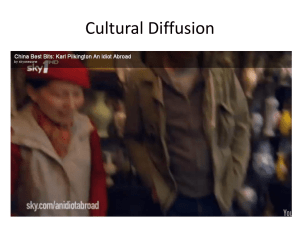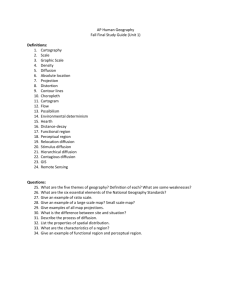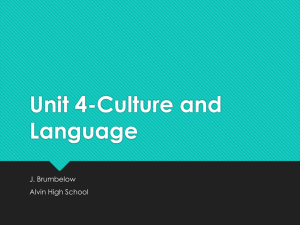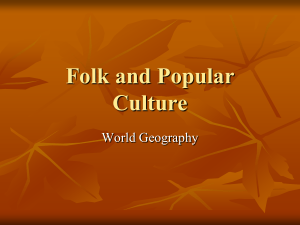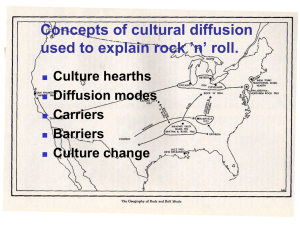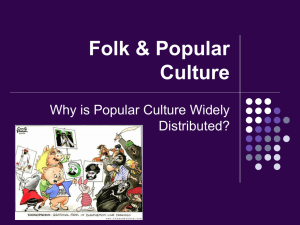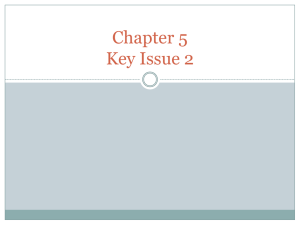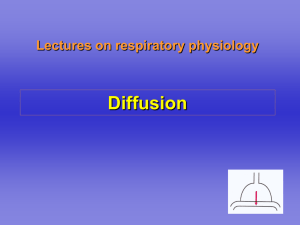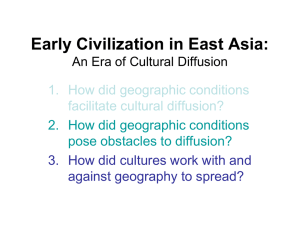WHAT IS CULTURE?
advertisement
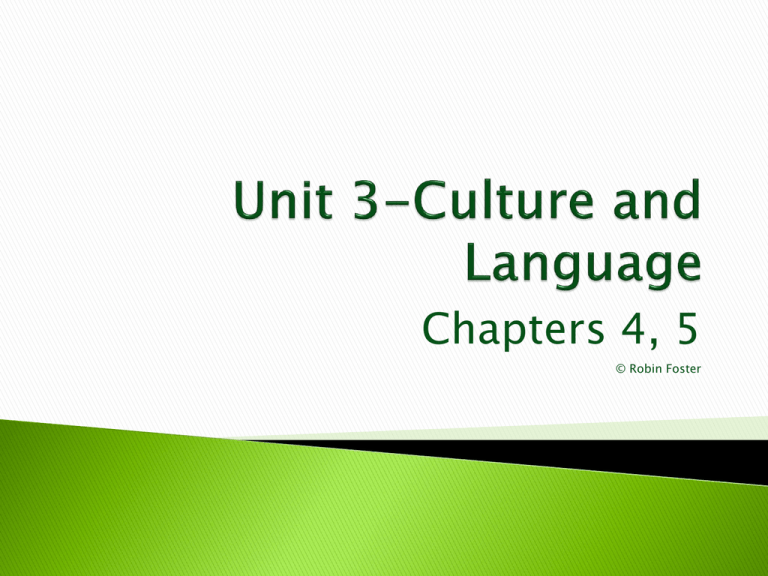
Chapters 4, 5 © Robin Foster Acculturation Assimilation Cultural convergence Cultural hearth Cultural landscape Cultural region Cultural trait Custom Diffusion Folk culture Habit Material culture Popular culture taboo Term Def Ex/Pic/ Sent Symbol Chapter 4 Culture Think about your culture. ◦ Think about what where your family is from. ◦ Think about the language you speak. ◦ Think about the way you look: hair color, eye color, facial features/shape, etc. ◦ Think about your mannerisms. ◦ Think about the clothes you wear. ◦ Think about the religion you practice. ◦ Think about the traditions you have. ◦ Think about the holidays you celebrate. Briefly describe your culture. Culture is the complex mix of values, beliefs, behaviors, and material objects that form a peoples’ way of life. Cultural landscape-the modification of the natural landscape by human activities. Cultural Ecology is the field that studies the relationship between the natural environment and culture. How a person adapts to a new culture. We all use adaptive strategies. Ms. Foster moved from the North to the South. What makes her crazy about living in the South? There are some very distinct differences. A wide range of concrete human creations, sometimes called artifacts that reflect values, beliefs and behaviors. Consists of abstract concepts of: ◦ Values-culturally defined standards that guide the way people assess desirability, goodness, beauty and serve as guidelines for moral living. ◦ Beliefs-statements people hold to be true, and they are almost based on values. ◦ Behaviors or actions that people take based on beliefs, values and norms (rules and expectations by which a society guides the behavior of members.) A habit is a repetitive act that a particular individual performs. Example: jeans on Friday, getting dressed. A custom is a repetitive act of a group performed to the extent that it becomes a characteristic of the group. Example: 4th of July fireworks An area marked by culture that distinguishes itself from other regions A single attribute of a culture Areas where civilization first began. Mesopotamia Indus Valley Nile Valley Geographers consider the areas stretching above and below the Sahara Desert as part of the African continent. Some geographers feel the cultures of North Africa are more closely associated with those of the Middle East than with the Sub-Saharan Africa. This shows that- a. Cultural characteristics can be used to define regions. b. Africa was subjected to European imperialism. c. Most Africans would like to emigrate to the Middle East. d. North Africa’s physical features prevented contact with the Middle East. Diffusion-the movement of goods, people or ideas. Cultural diffusion has spread culture traits to most parts of the world. Trace your hand on a blank piece of white paper. Follow the fingers around to create your “I AM” hand poem. Examples will be provided in class. ◦ ◦ ◦ ◦ ◦ ◦ ◦ ◦ ◦ ◦ I am (heritage/ethnicity, etc.). I have (2 cultural traits – clothing, hair/eye color, etc.) I hear (cultural songs, traditional poems, etc.) I believe (religion/religious ideas, etc.) I am (heritage/ethnicity repeated) I can/have (cultural achievement, expression etc.) I celebrate (custom, holiday, religious celebrations, etc.) I perform/I play (fine arts or dance of culture) I am (heritage/ethnicity repeated) Decorate with jewelry that represents your culture (rings, bracelets), symbols of your culture, and color it! An innovation or idea develops in a source area and remains strong there while spreading outward. Contagious Diffusion: nearly all adjacent individuals are affected (like dropping a rock in water). Time –distance decay-trait weakens as distance increases. Ideas and artifacts spread first between larger places or prominent people and only later to smaller less prominent people. Relocation Diffusion: the actual movement of individuals who have already adopted an idea or innovation and carry it to a new, perhaps distant locale, where they proceed to disseminate it. Migrant diffusion: when an innovation originates somewhere and enjoys strong but brief adoption there Italian immigrants to New York City taught IrishAmericans how to make pizza (pizza, of course, originated in Italy). A less dominant culture adopts the traits of more influential ones. Americans adopting Indian Culture The dominant culture completely absorbs the less dominant one. Portrait of Native Americans from the Cherokee, Cheyenne, Choctaw, Comanche, Iroquois, and Muscogee tribes in American attire. Photos dates from 1868 to 1924. Culture can be categorized according to spatial distribution into two basic types: Folk Culture Popular Culture Folk Culture is traditionally practiced by small, homogenous groups living in isolated rural areas. Small Incorporates homogeneous population Typically rural Cohesive in cultural traits Work to preserve those traits in order to claim uniqueness Folklore-stories passed on from generation to generation. Jack tales-stories that involve the character Jack. Folk culture is in a relatively small area. Popular Culture is found in large heterogeneous societies that are bonded by a common culture despite the many differences among the people who share it. 1960’s jeans were associated with low status laborers and farmers. Levi’s are a status symbol in may parts of the world. Popular culture flourishes in countries here people have sufficient income to acquire the tangible elements of popular culture. Pop culture is ever changing Large Incorporates heterogeneous populations Typically urban Experiences quickly changing cultural traits Practiced by people across identities and across the world Also encompasses material and nonmaterial culture Practiced in wider area, popular culture usually spreads through contagious diffusion. Smiling is my favorite. 2. Run Forest! Run! 3. Cut it Out! 4. How Ruuuuude! 5. I can show you the world. 6. I’m gonna kill him! I’m gonna finish him like cheesecake. 7. Nobody puts Baby in the corner. 8. Frankly my dear, I don’t give a damn. 9. Taste the rainbow. 10. To Infinity and beyond. 11. Stupid is as stupid does. 12. Save money. Live better. 1. 13.Did I do that? 14. What you talkin’ ‘bout, Willis? 15. I like that boulder, that is a nice boulder. 16. If you can dodge a wrench, you can dodge a ball. 17. I feel the need. . . The need for speed. 18. May the force be with you. 19. Hakuna Matata. 20. Just keep swimming. 21. Who ya gonna call? 22. You raaaaang? 23. That’s the way the cookie crumbles. 24. You’re killing me smalls. Let’s look at several segments of culture: Music Food Sports Architecture https://www.youtube.com/watch?v=PWgvGjAhvIw Culture can be analyzed through music. Elvis Who? Listening habits of a particular group of people is to analyze the radio stations they listen to. What radio station do you listen to? What’s your ringtone? Country Bluegrass Blues Tejano Cajun Polka Motown Dance dance2 You must sit quietly! And wait for further directions. If you’re talking, you will get 20 points deducted from your grade Food is a terrific way to understand culture because certain areas have dishes that are distinct to their cuisine American fast food has invaded the world. ( as a product of diffusion) Chowder NE-is a white chowder NY- is tomato based BBQ—some sauces are mustard, ketchup, tomato or vinegar based. Dry BBQ-sauce cooked in Wet BBQ-sauce added after meat is cooked. Meat-port or beef? Food Attractions: ◦ Some things are eaten because they enhance some characteristic the culture deems important Reasons for Food Taboo: ◦ Some things embody negativity ◦ Protect the environment ◦ Religion and social values ◦ Nutritutional values Country/ Location/Group Taboo USA Swan, dog, cat, elephant, rats, mice Hinduism cow Judaism Shellfish, elephant, pork Somali Clans (Somalia) fish Quebec Horse Muslims pork England/Ireland Snail Denmark-sandwiches called smorrbrod, eaten open face with a knife and fork. Rotted SharkOnce the shark is “ripe” enough it is eaten. Yummy? Guinea pigs called cuy are a delicacy. Served for special occasions such as anniversaries and birthdays. Blowfish or Fugu is a delicacy in Japan. Costing as much as $200/plate. You can die, if prepared incorrectly. UK--Fish and chips Clay Paint chips Cornstarch Coffee grounds Cigarette ashes Glue Hair Feces Paper sand The habit of eating clay, mud or dirt. Many say there are health benefits and that dirt from different areas tastes different. People travel to this site in New Mexico. They believe the ground is sacred and travel here to eat dirt. Sports are associated with culture. The spread of baseball and basketball around the world from the USA is a form of hierarchical diffusion. Sports Soccer is the #1 sport in the world. Football Soccer Baseball Basketball Lacrosse Cricket Tennis Golf What sports fan are you? The architecture of residential, commercial and spiritual structures vary greatly throughout the world. Housing styles vary according to climate and available building materials. Brick/wood Flat/peaked roof Basement? One story/multi-story Single/multi family TV is the most popular leisure activity in MDC’s throughout the world. TV is the most important mechanism by which popular culture such as sports is rapidly diffused throughout the earth. Diffusion of internet follows a pattern of television diffusion. The internet connects the world, making cultural diffusion happen at a rapid pace. Without the internet, what would you do? People who see themselves as a part of a community that works to preserve their traits and customs. Chapter 5 Language Language is a system of communication through speech. Oldest cultural trait on earth. Language not only allows for communication, but continuity of culture In most cases language is spoken and written. Official language-language used by government for laws, reports, and public documents. A country can have more than 1 official language. Standard language-a particular variety of a language that has been given either legal or quasi-legal status. Top 10 Most Commonly Spoken Languages 1. Chinese-14.9%(Mandarin, Wu) 2. Spanish-5.05% 3. English-4.84% 4. Hindi 5. Arabic 6. Portuguese 7. Bengali 8. Russian 9. Japanese 10. Standard German Spoken by more than ½ a billion people. The British were responsible for the diffusion of English. Migration of British to other parts of the world diffused English. You may not be able to understand the regional dialects. Dialects Line Motor home Mail Fries Parking lot Sweater Highway Apartment Cookie American English Queue Caravan Post Chips Car park Jumper Motorway Flat Biscuit British English A collection of languages within a branch that share a common origin in the relatively recent past. Displaying a relatively few differences in grammar and vocabulary. Evolved from Latin. Spain, Portugal, France and Italy- are the countries of the original Romance Languages. Romanian is the 5th Romance Language Latin and Hebrew have literary traditions. Dialects exist within the Romance Languages-Castilian. Sino-Tibetan-Mandarin Chinese Afro-Asiatic-Arabic Austronesian-SE Asia Dravidian-India Altaic Asia Niger-Congo-Africa Japanese Represent concepts rather than sounds 240 characters build are built into complex words. Thousands of extinct languages-once in use but no longer spoken or read in daily activities anywhere. Examples include: ◦ ◦ ◦ ◦ Gothic-E/N Europe Welsch-Wales Quechua-Peru Hebrew Speak more two or more languages in a country 4 languages in the country. German, French, Italian and Romansh English for the majority of the country. Quebec is the French speaking province. Need for common language for communication. Lingua Franca-language of international communication is English. Mix elements of two languages into a common language. Ebonics-a combination of Ebony and phonics. Example: She be at home Ebonics is controversial. Appalachian dialects- Quick, call an am-bew-lance. Many are considered a sign of poor education by outsiders. Franglais-a combination of French and English. Spanglish-Spanish and English. Le Jogging ◦ The word carpeta is "folder" in standard Spanish. In some Spanglishes it means "carpet" (room rug). Denglish-German and English Ich musste den Computer neu booten / rebooten, weil die Software gecrasht ist. I had to reboot the computer because the software crashed. The study of place names. Cultural identity and history can be revealed by noticing names of geographic and political features. New York Rio Grande-”Big River” in Spanish Rocky Mountains Language can be a barrier for many international travelers. Language barriers for immigrants. Language dialects as a part of regional culture. Literacy-the ability to read and write in your native language.
